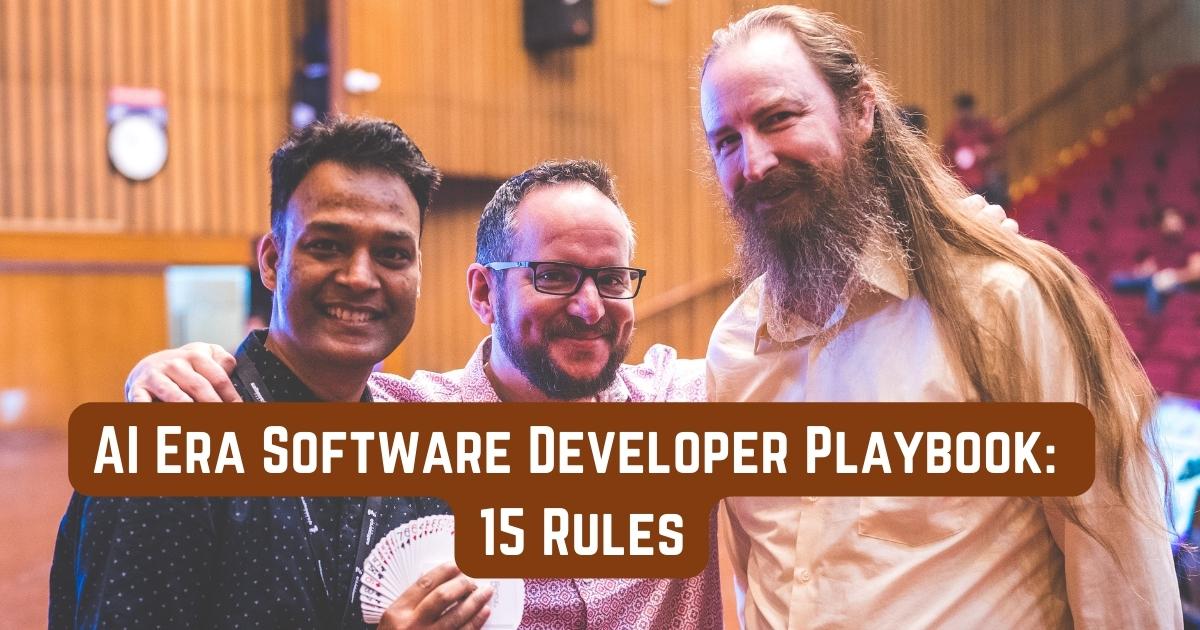In 2023, the fusion of AI and traditional software development is more than just a trend; it's a seismic shift that's redefining the rules of the game. Gone are the days when developers could afford to be specialists in just one area. Today, they're expected to be Swiss Army knives, equally adept at coding and leveraging AI to solve complex problems. This isn't just a new chapter in software development; it's an entirely new book. And for those willing to adapt, the opportunities are limitless.
As we navigate this AI-infused landscape, it's clear that the old playbook just won't cut it. Developers now find themselves at the crossroads of coding and AI, a junction teeming with both challenges and opportunities. But fear not, we've got you covered. Here's your new playbook, a comprehensive guide to thriving in this brave new world.
1. AI Literacy is the New Black
As AI technologies become increasingly integrated into software solutions, a basic understanding of AI is essential for every developer.
Action Steps:
- Online Courses: Begin by taking online courses that cover the fundamentals. Topics to focus on include neural networks, natural language processing, and reinforcement learning.
- Follow Thought Leaders: Stay updated by following AI thought leaders on social media. Some notable figures include Andrew Ng, Yann LeCun, and Fei-Fei Li.
- Research Publications: Subscribe to AI-focused journals and newsletters like arXiv's AI section or MIT Technology Review's AI coverage to stay on top of the latest research and trends.
- Must-Read Books: To deepen your understanding of AI, consider adding these books to your reading list:
By taking these steps, you'll not only understand the jargon but also grasp the underlying concepts that are shaping the future of software development in the age of AI.
2. Ethics Aren't Optional: Why You Should Care and What You Can Do About It
Let's get real—ethics in AI isn't a "nice-to-have," it's a "must-have." As developers, we're not just coding machines; we're shaping the future. And that future could be riddled with bias, discrimination, and a lack of accountability if we don't get our ethical house in order.
The Ethical Landscape: What's Hot Right Now
- AI Bill of Rights: Fresh off the press from the White House, this is the ethical blueprint you didn't know you needed. It's all about safe systems, non-discrimination, and data protection. Get the scoop here.
- Microsoft’s Six Principles: Microsoft isn't playing around. They've got six principles that are making waves in the AI community. Fairness, transparency, and accountability are just the tip of the iceberg. Dive in.
- United Nations Guidelines: When the UN speaks, you listen. Their 10 principles are the ethical compass for AI, focusing on human rights, fairness, and transparency. Check it out.
- The Belmont Report: This isn't new, but it's gold. Originally for human research ethics, its principles are now the go-to for AI ethics. Read why.
The Hot-Button Issues
- Jobocalypse: Yeah, AI could take jobs. What are you going to do about it?
- Bias Alert: If your AI discriminates, you've got a PR nightmare waiting to happen.
- Who's to Blame?: If your AI messes up, who takes the fall?
- Peekaboo, I See You: Data privacy is no joke; get it wrong, and you're in hot water.
- The Legal Maze: IP issues around data are the new courtroom drama.
- Eco-Unfriendly: Your AI's carbon footprint could be a deal-breaker.
Your Ethical Toolkit: Read, Learn, Follow
Your ethical toolkit to read, learn and follow include:
- Books:
- Courses:
- Influencers:
- Journals:
So, there you have it. Ethics in AI is non-negotiable, and you've got the tools to make it happen. Now go out there and code like the ethical rockstar you are.
3. Code Clarity in the AI EraWhy It's a Big Deal and How to Nail It
In the AI era, code isn't just functional—it's a work of art. But unlike a Jackson Pollock painting, your code needs to be decipherable, not just by you but by your entire team. As AI models get more complex, the code that surrounds them can't afford to be a hot mess.
The Latest Trends in Code Clarity
- Self-Documenting Code: It's 2023, and self-documenting code is the new black. Forget excessive comments; your code should explain itself. Learn more.
- Code Reviews with AI: AI isn't just for end-users. Developers are using AI-powered tools for code reviews, making sure that clarity isn't compromised. Check it out.
- Modular Programming: Breaking down your code into smaller, reusable modules is in vogue. It makes your code easier to manage and understand. Read why.
The Nitty-Gritty: What You Need to Know
- Variable Names Matter: Gone are the days of 'x' and 'y'. Descriptive variable names are in.
- Comment Wisely: Comments should add value, not clutter. Use them to explain the 'why,' not the 'what.'
- Indentation is Key: Proper indentation isn't just for aesthetics; it's for readability.
- DRY (Don't Repeat Yourself): Redundancy is so last year. Keep your code DRY to make it easier to maintain.
Your Toolkit: Read, Learn, Follow
Your toolkit to read, learn and follow include:
- Books:
- Courses:
- Influencers:
- Journals:
So, there you have it. Code clarity in the AI era is non-negotiable. With these tools and trends, you'll be writing crystal-clear, team-friendly code in no time. And remember, in the world of AI, clarity isn't just king—it's the whole royal court.
4. Data Wrangling 101: The Unsung Hero of AI Development
Data is the lifeblood of AI, but let's face it, raw data is often messy and unstructured. Enter data wrangling—the unsung hero that turns your chaotic data into a well-organized dataset, ready for AI modeling. Without proper data wrangling, you're essentially feeding your AI algorithms junk food. And we all know how that ends.
The Latest Trends in Data Wrangling
- Automated Data Collection: In 2023, manual data entry is as outdated as flip phones. Automated data collection from APIs, databases, and IoT devices is where it's at. Learn more.
- AI-Driven Data Cleaning: AI isn't just the endgame; it's also revolutionizing the data cleaning process. Think of AI algorithms that can automatically detect and handle outliers. Check it out.
- Feature Engineering: This isn't your grandma's feature selection. Advanced techniques like dimensionality reduction and feature scaling are making waves. Read why.
The Nitty-Gritty: What You Need to Know
- Missing Values: These are the bane of any dataset. Techniques like mean imputation and regression imputation are your friends here.
- Data Transformation: One-hot encoding, label encoding, and normalization are your go-to methods for making your data AI-friendly.
- Data Validation: Cross-validation and holdout validation methods help you sleep at night, knowing your data is up to snuff.
Your Toolkit: Read, Learn, Follow
Your toolkit to read, learn and follow include:
- Books:
- Courses:
- Influencers:
- Journals:
So, there you have it. Data wrangling is not just a preliminary step; it's a cornerstone of successful AI development. With these tools and insights, you'll be wrangling data like a pro, ensuring your AI models are as accurate as they are innovative.
5. Automation is Your Ally
In a world where time is money, automation is the golden ticket for developers. AI-driven automation tools are not just a nice-to-have but a must-have in the developer's toolkit. They can handle the mundane, repetitive tasks, freeing you to focus on the more complex and creative aspects of coding.
Action Steps:
- Identify Automation Opportunities: Before diving into AI-powered tools, identify the tasks that are ripe for automation. Whether it's code generation, testing, or debugging, knowing what to automate is half the battle. LinkedIn has some insights on this.
- Choose the Right Tools: There's a plethora of AI tools designed for developers. From code completion tools like Tabnine to AI-powered debugging solutions, the market is flush with options.
- Use AutoML for Training Models: Google's AutoML is a game-changer for those with limited machine learning experience. It simplifies the data preparation and model training stages, allowing you to automate complex tasks with ease. DreamFactory recommends it as a best practice.
- Opt for TensorFlow for Deployment: TensorFlow is an open-source machine learning framework that excels in model deployment and management. It's a community favorite and comes highly recommended for any AI-powered automation task.
- ML Lifecycle Management: Platforms like Amazon SageMaker, Azure Machine Learning, and Google Cloud AI Platform can help you manage your machine learning models effectively. These platforms guide you through the model management stage, which is crucial for the success of AI in software development.
- APIs for Future Innovation: Including APIs in your AI software projects can provide a platform for future innovation. Whether public or private, APIs can extend the reach and utility of your AI-powered features. DreamFactory also emphasizes the importance of API management in AI projects.
By embracing AI-driven automation, you're not just streamlining your workflow; you're future-proofing it. In the fast-paced world of tech, that's not just smart—it's essential.
6. Cut Through the AI Hype: The Developer’s Reality Check
AI is the buzzword du jour, but let's not get carried away. While AI offers groundbreaking possibilities, it's crucial to separate the wheat from the chaff. Not every problem requires an AI solution, and not every AI tool lives up to its hype. Being discerning about AI's role in your development process is more than just wise—it's essential.
Action Steps:
- Trust but Verify: AI is making inroads into development, with 44% of developers already using AI tools and 26% planning to do so. However, only 3% highly trust these tools. The mantra here is "trust but verify." Stack Overflow's 2023 Developer Survey offers a deep dive into these stats. Yours truly’s very own 2023 AI & ML Developer Survey is a treasure of information. You can download the 150 page PDF.
- Be Skeptical of the Toolset: Most developers are using just two popular products: ChatGPT and GitHub Copilot. Before jumping on the bandwagon, evaluate if these tools genuinely add value to your workflow.
- Geographical Trends: Developers in India, Brazil, and Poland are more likely to use AI tools, while those in the UK, France, the US, and Germany are more skeptical. Keep an eye on global trends; they often indicate where the industry is headed.
- Regulatory Landscape: With imminent EU regulations and companies setting their own AI policies, being aware of the legal landscape is crucial. It could affect your choice of tools and how you implement them.
- Complexity Cliff: AI has its limitations. After a certain point, the ability for AI to handle all the nuances of a solution drops off. That's when human judgment becomes invaluable.
- Future Outlook: While 77% of developers feel that AI will significantly change code writing in the next year, it's essential to stay grounded. AI is a tool, not a magic wand.
Your Toolkit: Read, Learn, Follow
Your toolkit to read, learn and follow include:
- Books:
- Courses:
- Influencers:
So, while AI is undeniably transformative, it's not the end-all-be-all. By taking a measured approach, you'll be better positioned to leverage AI's strengths without falling for the hype.
7. The New Power Couple: Devs and Data Scientists
The fusion of development and data science is more than a trend; it's a necessity. As AI and machine learning become integral to software solutions, the collaboration between developers and data scientists is no longer optional—it's imperative. The synergy between these two roles is the secret sauce for innovation and efficiency in today's tech landscape.
Action Steps:
- Pair Programming: This isn't just for developers anymore. Data science teams are finding value in pair programming, a technique where two people code collaboratively. It enhances communication, creativity, and productivity. The New Stack delves into how this approach is particularly beneficial for data science.
- Speak the Same Language: Establish a common language for effective communication. Whether it's about data models or code repositories, clear and consistent dialogue is key.
- Lean Experimentation: Data scientists often engage in a cycle of model training and validation. Developers can contribute by automating these cycles and integrating them into the development workflow.
- Shared Accountability: Both roles should take ownership of the project's success. This includes everything from data collection to model deployment. Shared accountability ensures that everyone is invested in the project's outcome.
- Reproducibility: Ensure that your code and data models are easily reproducible. This is crucial for both debugging and future project phases.
Your Toolkit: Read, Learn, Follow
Your toolkit to read, learn and follow include:
- Books:
- Courses:
- Influencers:
By embracing the collaborative spirit, developers and data scientists can unlock new levels of innovation and efficiency, driving projects that are both technologically advanced and user-focused.
8. Never Stop Learning: The Developer’s Lifelong Journey
In the fast-paced world of tech, standing still is akin to moving backward. The landscape is ever-changing, especially with the advent of AI and machine learning. Continuous learning isn't just a buzzword; it's a career necessity. As Forbes puts it, "upskilling shouldn’t just be a one-time event but a career-long journey."
Action Steps:
- Set Clear Goals: Define what you want to achieve in your learning journey. Whether it's mastering a new programming language or understanding the intricacies of neural networks, having clear objectives will guide your efforts.
- Curate Your Learning Resources: Don't just rely on one source. From webinars and podcasts to specialized courses, diversify your learning platforms.
- Seek Mentorship: A mentor can provide invaluable insights into industry trends and best practices. They can also help you navigate the complexities of combining traditional software development with AI.
- Stay Updated: Keep an eye on industry reports, publications, and job boards. Knowing what skills are in demand can help you tailor your learning path.
- Apply What You Learn: Theory without practice is futile. Make sure to apply your newly acquired skills in real-world projects, even if they are just for practice.
Your Toolkit: Read, Learn, Follow
Your toolkit to read, learn and follow include:
- Books:
- Deep Work by Cal Newport for mastering the art of focused learning.
- The Pragmatic Programmer by Andrew Hunt and David Thomas for timeless software development wisdom.
- Courses:
- Influencers:
By committing to a culture of continuous learning, you're not just future-proofing your career; you're also setting yourself up for immediate success and innovation.
9. Rethink Testing
Traditional testing methods often fall short when applied to AI components. The AI algorithms are not deterministic in the way that traditional software is, which means they can behave unpredictably. This new landscape requires a fresh approach to testing that accounts for the complexities of AI.
Action Steps:
- Adopt AI-Specific Metrics: Traditional metrics like code coverage might not be sufficient for AI components. Learn about AI-specific metrics such as precision, recall, and F1 score. These metrics give a more nuanced view of an AI model's performance. For example, precision measures the number of true positive results among the number of positive results returned by the model. InfoQ offers a deep dive into how AI and ML are changing the software testing landscape in 2023.
- Risk-Based Testing: With AI, it's crucial to focus your testing efforts where they're most needed. Risk-based testing uses machine learning to analyze previous development, testing, and release activities to learn where defects have been found and problems have historically occurred. This allows you to allocate your resources more effectively.
- Automate with Caution: AI can help automate many testing tasks, but it's not a silver bullet. Automated tests can become brittle and may not adapt well to changes in the AI algorithms they're testing. Use machine learning to make your automated tests more resilient. Tools are emerging that use ML to scan applications in multiple ways over multiple iterations, learning what range of results is "correct" and what is "incorrect."
- Security Testing: AI is also transforming the cybersecurity landscape. AI algorithms are now being used to probe systems actively to find weaknesses and vulnerabilities. Make sure to include security testing as part of your AI testing strategy.
- Human Oversight: Despite the advances in AI, human intuition and expertise are irreplaceable in the testing process. Always have a human in the loop to validate the AI's decisions and to provide ethical oversight.
By rethinking your approach to testing in the AI era, you're not just keeping up with the times; you're staying ahead of the curve. The future of software testing is here, and it's teeming with AI-driven possibilities.
10. Scale or Fail
AI models can be resource-intensive, affecting application performance. As AI becomes more deeply integrated into software, the ability to scale these models without sacrificing performance becomes a critical skill for developers.
Action Steps:
- Understand the Risks: Before scaling, understand the potential pitfalls such as productivity erosion and the need for high standards on security, regulatory, and ethical compliance. McKinsey provides a deep dive into the challenges and enablers for scaling AI.
- Leverage Data Products: Use feature stores to optimize the process of feature engineering, thereby accelerating the development and deployment of ML models. Feature stores can also help maintain version control of features and track data lineage.
- Code Assets: Reusable code packages can expedite the development process, reduce costs, and support a consistent, maintainable, and flexible software structure. This modular approach makes AI/ML projects leaner and more efficient.
- Standards and Protocols: Implement a robust framework of standards and protocols that provide guidance for data teams on how to build, evaluate, and deploy ML models. This ensures safety, consistency, and efficiency while scaling data and AI within an organization.
- MLOps: Machine Learning Operations (MLOps) is the technology and best practices that ensure that ML models are robust and efficient prior to deployment. It automates key tasks, facilitates collaboration between teams, and provides robust deployment pipelines and monitoring mechanisms.
By taking these steps, you're not just scaling; you're scaling smartly. You're ensuring that as your AI models grow, they do so in a way that's sustainable, ethical, and, most importantly, effective.
11. UX is King, AI or Not
In the tech world, there's a saying: "If the user interface is the joke, then the user experience is the punchline." This holds true even in the age of AI. As AI technologies become more integrated into software development, the role of UX (User Experience) design becomes increasingly critical.
Why UX Matters in AI
AI can automate tasks and provide personalized experiences, but it's the UX design that determines how users interact with these AI-powered features. For instance, a chatbot can either be a user's best friend or worst nightmare, depending on its design. A well-designed chatbot can guide users smoothly through tasks, while a poorly designed one can lead to user frustration and task abandonment.
UX design also plays a crucial role from an ethical standpoint. Poorly designed AI can perpetuate biases or even discriminate against certain user groups. Therefore, incorporating UX design into AI development ensures that the technology is fair, unbiased, and meets the needs of all users. Read more.
Tools to Enhance UX in AI
- Uizard: This web-based design tool uses AI to turn wireframes or sketches into fully functional and customizable design prototypes.
- Figma: Known for its "Auto Layout" feature, Figma uses algorithms to automatically adjust elements in a design when the content changes.
- Adobe Sensei: This tool can identify patterns, classify data, and generate personalized recommendations based on user behavior.
- ChatGPT: Unlike traditional "lorem ipsum" filler text, ChatGPT can generate coherent and meaningful text that closely resembles natural language, useful in UX research.
- Attention Insight: This tool uses AI to predict how users will interact with a design by analyzing visual attention patterns.
Key Takeaways
- AI won't replace UX designers; it will augment their capabilities.
- UX designers need to understand the strengths and limitations of AI tools.
- Ethical considerations are paramount when integrating AI into UX design.
By understanding the relationship between AI and UX design, considering the impact of AI on the role of UX designers, and exploring the benefits and limitations of AI tools, we can create more effective, efficient, and engaging user experiences.
12. The AI-First Shift
Welcome to the AI-first era, where the buzz isn't just about integrating AI into existing systems but about rethinking software development with AI at its core. This shift is more than a trend; it's a fundamental change in how we approach coding, problem-solving, and even team dynamics.
Why It Matters
The AI-first approach is not just a buzzword; it's a paradigm shift in software development. AI technologies like Generative AI are forcing organizations to rethink their workflows and what should be adjusted. The potential is thrilling, but there are also risks and guardrails that need to be considered. For example, Generative AI has accelerated software development speed, but it still needs human supervision for code correctness and security. Read more.
Action Steps
- Embrace Generative AI: Tools like GitHub Copilot and ChatGPT can help developers focus on generating value rather than writing boilerplate code.
- Security First: Always follow best practices and avoid including credentials and tokens directly in your code. AI might be capable of breaking security if not handled carefully.
- Test Small, Scale Smart: Before fully adopting AI, implement small use cases and test them rigorously. If they work, scale them; if not, pivot.
- Educate and Upskill: Understanding how to phrase prompts for AIs is crucial. Invest in educational programs and training courses for your team.
- Set Guardrails: Establish guidelines and best practices for leveraging AI in your organization to mitigate risks related to security, ethics, and legality.
Key Takeaways
- AI will augment developers, not replace them.
- Security and ethical considerations are paramount.
- The AI-first shift is not without its challenges, but the rewards can be substantial for those who navigate it wisely.
By embracing the AI-first shift, you're not just keeping up with the times; you're staying ahead of the curve. This is the future of software development, and it's happening now. Are you in?
13. Document Like Your Life Depends On It
In the AI-first world, documentation isn't just a nice-to-have; it's your lifeline. As AI technologies add layers of complexity to software projects, the importance of robust, clear, and comprehensive documentation has never been higher. It's not just about code comments; it's about creating a roadmap for your team, stakeholders, and even for yourself.
Why It Matters
Documentation serves as the cornerstone of efficient communication between software engineers, users, and stakeholders. It bridges the gap between complex code and clear instructions, allowing seamless collaboration and facilitating smooth software implementation. Poor or insufficient documentation can disrupt maintenance, scaling, and updating the system. It can also lead to budget overruns, missed deadlines, and new features riddled with errors. Read more.
Action Steps
- Software Architecture Design: Document the principles of system development, its key elements, and objectives. Include data flows and architectural solutions.
- API Documentation: Use tools like Swagger to automatically create and update your API documentation. List APIs that could be useful for future upgrades.
- Source Code and Tech Stack: Explain how the code works and how the system was developed. Cover all front-end and back-end frameworks.
- Quality Assurance: Include information about the product’s quality and all testing activities. List requirements and principles your product has to meet.
- Maintenance Documentation: Provide instructions and recommendations for the software maintenance team. Include common issues and ways to manage them.
Key Takeaways
- Documentation is not just for onboarding new team members; it's a living, breathing entity that evolves with your project.
- The quality of your documentation can make or break your project.
- In the age of AI, documentation needs to cover not just the "how" but also the "why" behind using specific AI models or datasets.
By taking documentation seriously, you're not just avoiding headaches down the line; you're setting your project up for long-term success. So, document like your life depends on it—because, in this complex landscape, it just might.
14. Code Green
In the AI-first world, documentation isn't just a nice-to-have; it's your lifeline. As AI technologies add layers of complexity to software projects, the importance of robust, clear, and comprehensive documentation has never been higher. It's not just about code comments; it's about creating a roadmap for your team, stakeholders, and even for yourself.
Why It Matters
Documentation serves as the cornerstone of efficient communication between software engineers, users, and stakeholders. It bridges the gap between complex code and clear instructions, allowing seamless collaboration and facilitating smooth software implementation. Poor or insufficient documentation can disrupt maintenance, scaling, and updating the system. It can also lead to budget overruns, missed deadlines, and new features riddled with errors.
Action Steps
- Software Architecture Design: Document the principles of system development, its key elements, and objectives. Include data flows and architectural solutions.
- API Documentation: Use tools like Swagger to automatically create and update your API documentation. List APIs that could be useful for future upgrades.
- Source Code and Tech Stack: Explain how the code works and how the system was developed. Cover all front-end and back-end frameworks.
- Quality Assurance: Include information about the product’s quality and all testing activities. List requirements and principles your product has to meet.
- Maintenance Documentation: Provide instructions and recommendations for the software maintenance team. Include common issues and ways to manage them.
Key Takeaways
- Documentation is not just for onboarding new team members; it's a living, breathing entity that evolves with your project.
- The quality of your documentation can make or break your project.
- In the age of AI, documentation needs to cover not just the "how" but also the "why" behind using specific AI models or datasets.
By taking documentation seriously, you're not just avoiding headaches down the line; you're setting your project up for long-term success. So, document like your life depends on it—because, in this complex landscape, it just might.
15. Adapt or Perish
In the fast-paced world of AI and software development, adaptability isn't just a nice-to-have; it's a survival skill. The tech landscape is constantly shifting, and what worked yesterday may not necessarily work tomorrow. Enter adaptive AI, the next-gen AI system that adjusts its code for real-world changes, even when the coders didn't anticipate these changes. This is not just a buzzword; it's the future. Gartner predicts that organizations embracing adaptive AI will outperform competitors by 25% by 2026. Read more
Why It Matters
The ability to adapt is crucial in a world where over 95% of companies have AI initiatives underway. Adaptive AI systems can modify their behavior based on experiences, making them practical and relevant even in dynamic and unpredictable situations. This enables AI to deliver better outcomes faster, making your projects more resilient and efficient.
Action Steps
- Embrace Adaptive Frameworks: Move away from fixed, historical data and embrace adaptive AI frameworks that evolve to fit into an increasingly digital world.
- Continuous Learning: Implement machine learning algorithms that allow your technology to process and analyze new information, thereby making your systems more adaptable.
- Opt for Flexibility: Choose AI systems that adjust their algorithms and decision-making processes when they encounter changes in input data or the context in which they operate.
- Self-Review: Use AI systems that improve their capabilities over time by analyzing their own performance, identifying weak or inefficient areas, and refining their algorithms in response.
- Stay Updated: Keep an eye on the latest trends and technologies in adaptive AI. This will not only keep your projects current but also prepare you for future shifts in the tech landscape.
Key Takeaways
- Adaptability is not just a feature but a necessity in the ever-changing world of AI.
- Adaptive AI is the top strategic technology trend of 2023, and it's here to stay.
- The ability to adapt and evolve is what will set successful projects apart from the rest.
By embracing adaptability, you're not just future-proofing your projects; you're setting the stage for innovation and success in an industry that waits for no one.
Summary
So there you have it, the developer's new playbook for an AI-centric world. This isn't just a list of best practices; it's a roadmap for navigating a landscape that's as exciting as it is daunting. From mastering the art of AI literacy to embracing the power of adaptability, these 15 points are your keys to unlocking a future of endless possibilities. And let's be clear: this isn't just about keeping up with the Joneses. It's about outpacing them, outsmarting them, and ultimately, outperforming them.
In a world where AI is the new normal, standing still is not an option. The developers who will thrive are those who can not only code but also harness the transformative power of AI. So go ahead, dive into this playbook. Whether you're a seasoned developer or a newbie just getting your feet wet, these guidelines offer a treasure trove of insights that can propel you to the forefront of this exhilarating frontier. The future is not just coming; it's already here. And with this playbook in hand, you're more than ready to seize it.
Have questions or comments about this article? Reach out to us here.
Banner Image Credits: Speakers Michael Carducci and Rob Richardson with an attendee at Great International Developer Summit







